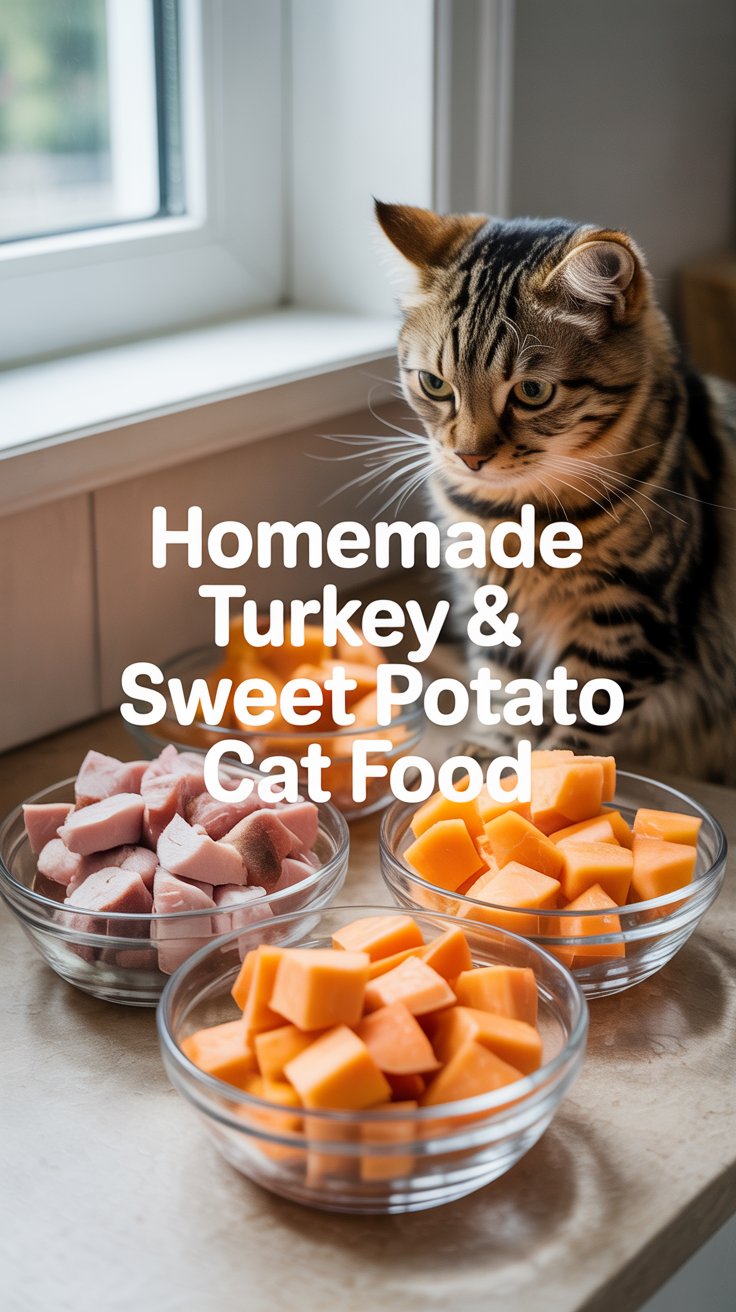If you’ve ever flipped over a bag of commercial cat food and thought, “What even is this stuff?” — you’re not alone.
More and more cat parents are turning to homemade meals to take control of their feline’s nutrition. The good news? It’s easier than it sounds — especially when you start with ground turkey.
Turkey is lean, easy to digest, and most cats absolutely love it. But before you toss some into a skillet and call it dinner, there’s a little more you should know.
✅ This guide will show you how to make balanced, vet-informed cat food using ground turkey — with essential nutrients, safe preparation steps, and expert tips included.
🍗 Why Ground Turkey Is a Great Base for Homemade Cat Food
Cats are obligate carnivores, meaning they biologically depend on meat to survive. Ground turkey is one of the best starter proteins for homemade cat food because:
- High-quality animal protein: Supports muscle maintenance and growth
- Low fat: Helps maintain a healthy weight
- Highly digestible: Easier on sensitive stomachs than beef or lamb
- Mild taste: Most cats love it (even picky eaters)
But — and this is key — turkey alone is not a complete meal.
Homemade cat food must be carefully balanced with specific nutrients like taurine, calcium, omega-3s, and B vitamins, or you risk long-term health issues like blindness, heart disease, and bone loss.
🛒 Ingredients (Vet-Friendly & Nutritionally Supportive)
Here’s what you’ll need to create a balanced homemade turkey meal for your cat:
✅ Core Ingredients:
- 1 pound ground turkey (organic or hormone-free if possible)
- 1 whole egg (includes yolk for biotin + white for protein)
- 1/4 cup plain pumpkin puree or cooked sweet potato (for gentle fiber)
- 1/2 teaspoon fish oil (sardine or salmon oil for omega-3s)
- 1/2 teaspoon taurine powder (essential for heart and eye health)
- 1 teaspoon ground eggshell powder (for calcium-phosphorus balance)
⚠️ NEVER add salt, garlic, onions, or spices. All of these can be toxic to cats.
Optional but helpful:
- Cat-safe multivitamin (like Rx Vitamins for Pets Nutritional Support or Balance IT Feline)
- B-complex or Vitamin E (if your vet recommends it for homemade diets)
🍳 Step-by-Step: How To Make Homemade Cat Food with Ground Turkey
Step 1: Cook the Turkey
- Add ground turkey to a clean skillet on medium heat
- Break it up into small pieces while cooking
- Do NOT add oil, butter, or seasoning
Step 2: Add the Egg
- When the turkey is about 80% cooked, crack in the egg (you can beat it separately if you prefer)
- Stir until the egg is fully cooked and mixed through — this adds binding texture and extra nutrition
Step 3: Mix in Fiber
- Turn off the heat
- Stir in pumpkin or sweet potato puree — this aids digestion and helps with hairballs or constipation
Step 4: Add Oils and Supplements (When Cooled Slightly)
- Let the mix cool to warm (not hot) before adding:
- Fish oil (omega-3s)
- Taurine powder
- Ground eggshell (calcium)
⚠️ Heat can degrade delicate nutrients like taurine and omega-3s, so always add them after cooking.
🥣 Serving Guidelines: How Much Should You Feed?
General rule:
Feed 2–4% of your cat’s body weight per day, divided into two meals.
For example:
- A 10-pound cat = 3–4 oz of food per meal (around 1/3 to 1/2 cup)
✨ Tip: Weigh your cat’s food with a kitchen scale for accuracy.
Let food cool to room temperature before serving. Store leftovers in the fridge for up to 3 days, or freeze in pre-measured portions for up to 2 months.
⚠️ Transition Tips: Don’t Switch Overnight
Suddenly changing your cat’s diet can upset their stomach. Here’s how to transition gradually:
| Days | Old Food | Homemade Food |
|---|---|---|
| Day 1–3 | 75% | 25% |
| Day 4–6 | 50% | 50% |
| Day 7–9 | 25% | 75% |
| Day 10+ | 0% | 100% |
If your cat shows signs of diarrhea or vomiting, slow the transition and consult your vet.
🧠 Expert Tips for a Healthier Homemade Diet
- ✅ Always use a supplement plan: Homemade food rarely meets 100% of feline nutritional requirements on its own
- ✅ Rotate proteins: Chicken, turkey, duck, and rabbit can be alternated for broader nutrient diversity
- ✅ Use a nutrition calculator: Tools like BalanceIT.com help you design meals that meet AAFCO standards
- ✅ Work with your vet: Especially if your cat is a senior, has kidney issues, or is on medication
- ✅ Avoid raw feeding (unless under veterinary supervision): Cooking eliminates harmful bacteria like salmonella and E. coli
🧼 Food Safety Reminders
- Wash hands, surfaces, and bowls thoroughly
- Use separate utensils for your cat’s food prep
- Refrigerate immediately after cooking
- Never leave homemade food out for more than 30 minutes
🎯 Final Thoughts: Is Homemade Worth It?
Homemade cat food with ground turkey is more than just a trendy DIY — it’s a conscious step toward cleaner, more biologically appropriate nutrition.
Unlike mystery kibble full of by-products and fillers, this recipe gives your cat:
✅ Real protein
✅ Natural fats
✅ Digestive support
✅ Essential nutrients
But remember: Homemade doesn’t automatically mean healthy. Balance and supplementation are what turn a bowl of turkey into a complete feline meal.
🐾 Your cat deserves food that matches their biology — not a bag of alphabet soup ingredients.
📌 Disclaimer
This recipe is meant as a short-term supplemental meal or a base for a vet-guided homemade diet. Always consult a veterinarian or feline nutritionist before feeding homemade food long-term.
